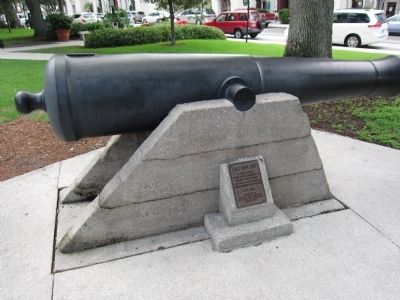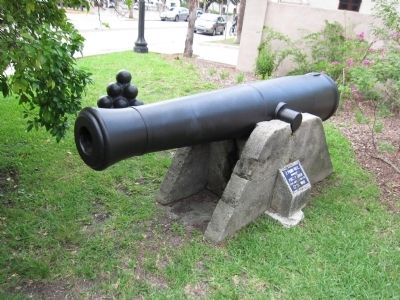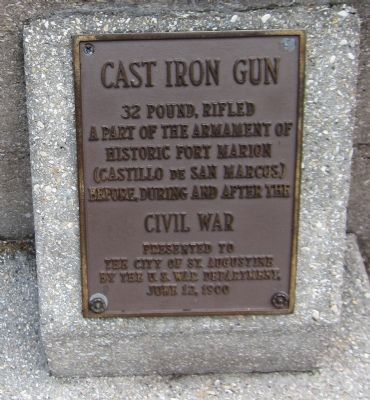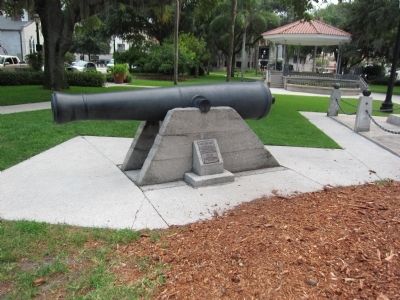Historic District in St. Augustine in St. Johns County, Florida — The American South (South Atlantic)
Cast Iron Gun
a part of the armament of
historic Fort Marion
(Castillo de San Marcos)
before, during and after the
Civil War
presented to
the city of St. Augustine
by the U.S. War Department,
June 12, 1900.
Erected 1900.
Topics. This historical marker is listed in this topic list: War, US Civil. A significant historical month for this entry is June 1830.
Location. 29° 53.545′ N, 81° 18.714′ W. Marker is in St. Augustine, Florida, in St. Johns County. It is in the Historic District. Marker is at the intersection of King Street and Charlotte Street, on the left when traveling east on King Street. Located in the Plaza de la Constitucion. Touch for map. Marker is in this post office area: Saint Augustine FL 32084, United States of America. Touch for directions.
Other nearby markers. At least 8 other markers are within walking distance of this marker. Public Well (a few steps from this marker); St. Augustine Foot Soldiers (within shouting distance of this marker); World War II Memorial (within shouting distance of this marker); 31 King Street (within shouting distance of this marker); The St. Augustine Foot Soldiers Monument (within shouting distance of this marker); Public Market Place (within shouting distance of this marker); Nuestra Señora de los Remedios (within shouting distance of this marker); Slave Market (within shouting distance of this marker). Touch for a list and map of all markers in St. Augustine.
Regarding Cast Iron Gun. Much like the 8-inch Columbiads also in the plaza, the plaque on these 32-pounders is probably in error. Although there were 32-pounder guns at Fort Marion before the Civil War, none were rifled. When Federals recaptured the fort in March 1862, they reported no rifled 32-pounders. Since these guns were at Fort Marion in 1900, the most likely story is the guns were deposited at the fort sometime during the Civil War or post-war. The fort was a backwater during (and after) the war where many obsolete guns remained well beyond their usefulness.

Photographed By Craig Swain, August 1, 2011
3. Second Gun
The second rifled 32-pdr faces Cathedral Street on the other side of the plaza. Like the first gun, this example was cast as a smoothbore in 1846. Also inspected by Alfred Mordecai, it received the registry number 5. The gun weighed 7215 pounds. Also like the other gun, this one received nine rifle grooves sometime during the Civil War.

Photographed By Craig Swain, August 1, 2011
4. Third Rifled Gun
A third 32-pdr rifled gun stands on the west side of St. Augustine government house. Notice the blue metal plaque providing the basic particulars. Like the others, this gun was cast in 1846 at Tredegar Foundry as a smoothbore and inspected by Mordecai. Registry number 30 weighed 7204 pounds. This gun was also rifled with nine grooves during the Civil War.
Credits. This page was last revised on January 2, 2019. It was originally submitted on September 3, 2011, by Craig Swain of Leesburg, Virginia. This page has been viewed 842 times since then and 33 times this year. Photos: 1, 2, 3, 4. submitted on September 3, 2011, by Craig Swain of Leesburg, Virginia.

